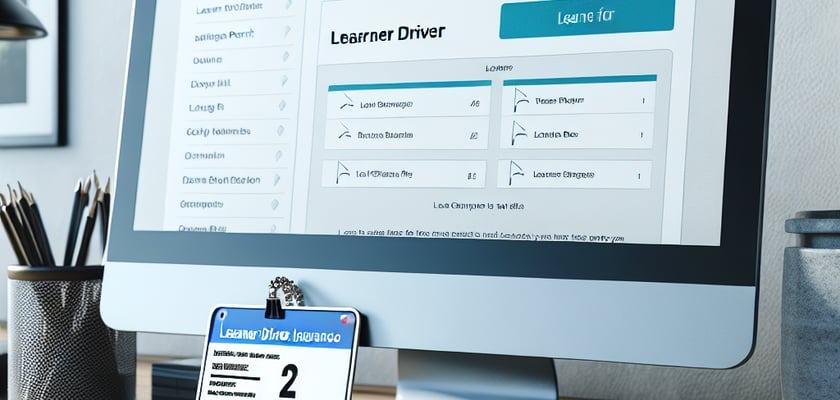Embarking on the rite of passage that is learning to drive is like stepping onto the most daunting roller-coaster at the theme park; you’re queasy with excitement and scared witless at the same time. But before you can yell “I passed,” you’ve got to navigate through the hairpin bends and loop-the-loops of getting learner driver insurance. This special insurance concoction has more variables than a calculus exam. Whether it’s battling through jargon denser than a rainforest or decoding cryptic clauses that feel like an FBI investigation, a learner’s road to being insured isn’t just about avoiding metaphorical traffic cones; it’s about ensuring you don’t pay a premium that’s heftier than your instructor’s sigh when you mixed up the clutch and the brake—again.
After much deliberation and several almost-heart-stopping moments of sticker shock, we’ve mapped out the treasure hunt route to those elusive insurance deals that don’t require you to sell an organ. Coming up, we’ll be dishing out the key takeaways faster than you can mistime a gear shift. Trust me; you’ll want to stick around for our nuggets of wisdom that might just save you enough cash to splurge on celebratory “I just parallel parked” cupcakes. Will we talk cold hard discounts that’ll make your wallet weep with joy? Perhaps introduce you to the art of haggling with insurance agents who have “I-can-smell-fear” senses? Or maybe even reveal how being a tad bit geeky with comparison charts can turn you into the savviest shopper on the block? Buckle up, learners, because we are about to accelerate straight into the juicy bits without any unnecessary pit stops—like a perfectly executed emergency stop test.
Key points I covered in this post
1. Research multiple insurance providers to compare coverage options and prices. Look for special deals or discounts specifically tailored towards learner drivers, and don’t hesitate to ask insurance representatives about any potential savings.
2. Consider adding a learner driver to an existing policy as a named driver if possible, as this can often result in lower premiums compared to taking out a separate policy. However, be sure to understand how this may affect the no-claims bonus of the main driver.
3. Choose the right type of car, as the make and model can significantly impact insurance costs. Opting for a vehicle that is in a lower insurance group, which typically includes cars with smaller engines and higher safety ratings, can lead to more affordable premiums.
4. Invest in supplementary driving courses like Pass Plus, as some insurance companies may offer discounts for additional driver qualifications which demonstrate safer driving practices and greater experience on the road.
5. Increase the excess on the policy, the amount you’re willing to pay in the event of a claim, to reduce the premium cost. However, ensure that the excess is affordable and consider any potential financial strain in the event that a claim needs to be made.
What Steps Should You Take to Secure the Best Deal on Learner Driver Insurance?
Securing the best deal on learner driver insurance involves comparison shopping, opting for a policy with a black box, leveraging multi-car insurance if you can be added to a family member’s existing policy, and looking out for discounts targeted at learners, such as those for students with good academic records or those who have taken driving courses. These strategies enable you to minimize costs while maximizing coverage as a new driver.
Evaluating Different Insurance Providers
Begin by researching various insurance providers to find those that specialize in or are friendly towards learner drivers. This can often result in lower premiums. Use online comparison tools to obtain quotes from several insurers, ensuring that the level of coverage is consistent across the board, which allows for direct price comparisons. Additionally, check each provider’s customer service reviews, claims process, and overall company reliability.
Incorporating Telematics (Black Box) Policies
Telematics, often referred to as black box insurance, monitors driving behavior through a device installed in the vehicle or an app on your smartphone. Insurers offer these policies at reduced rates because they encourage safer driving and can reduce the risk of accidents. The data collected can include speed, braking habits, and times of travel, incentivizing learners to adopt good driving habits from the outset.
Selecting the Right Level of Coverage
Understanding the different levels of coverage is vital. While comprehensive insurance offers the most protection, including for your own vehicle, third-party, fire, and theft might be a cost-efficient option if the car you are learning in is of lower value. Assess the car’s value, the cost of potential repairs, and weigh these against the premium differences to choose the most appropriate coverage level for your situation.
Opting for Higher Excess to Lower Premiums
Choosing a higher voluntary excess—that is, the amount you are willing to pay upfront in case of a claim—can significantly lower your premium. It’s a calculated risk, however, as it means you’ll need to cover a greater portion of the cost if you do need to make a claim. Ensure that the excess you agree to is affordable in the event of an accident.
Capitalizing on Discounts and Advanced Driving Courses
Certain insurers provide discounts to learner drivers who have completed an accredited driver’s education or advanced driving course. These courses not only improve driving skills but also demonstrate responsibility to insurers, which can help reduce insurance costs. Also, look out for discounts for students with good grades or those who drive under a certain number of miles annually.
Considering Adding a Named Driver
Adding an experienced driver with a good driving record as a named driver on your learner driver policy can often lead to lower insurance costs. Insurers view the inclusion of a seasoned driver on the policy as a lower risk proposition. However, it’s essential to use this method legitimately and avoid ‘fronting’, wherein the more experienced driver is falsely declared as the main driver to reduce costs, as this is illegal and could invalidate the insurance.
What Should You Keep in Mind While Identify Add-Ons and Optional Extras?
Many learner driver insurance policies offer additional features, such as breakdown cover. While these can be valuable, they also increase the premium. Carefully consider which add-ons you realistically may need, and compare the cost of including them in your policy versus obtaining them separately to ensure cost-effectiveness.
What Should You Remember About Policy Duration and Mileage?
Some insurers offer short-term learner driver insurance policies, which might be ideal if you’re planning to take your test soon and don’t require an annual policy. Conversely, a longer policy may be more cost-effective if you anticipate a lengthy learning period. Also, evaluate the mileage aspect carefully; if you won’t be driving much, a policy with a mileage cap can be cheaper.
1. Compare insurance providers and policies diligently, focusing on learner-friendly options.
2. Consider telematics-based insurance to potentially lower premiums and encourage safe driving habits.
3. Choose the level of coverage that best fits the value of the car and your personal requirements.
4. Opt for a higher excess if you want to reduce your monthly premiums, but make sure it’s affordable.
5. Look for discounts for taking driving courses or for displaying academic excellence.
6. Adding a named driver can reduce premiums, but avoid ‘fronting’ as it’s illegal.
7. Assess the value of add-ons carefully; only choose those that are necessary and cost-effective.
8. Evaluate whether a short-term or annual policy suits your learning timeline, considering the associated costs.
9. A policy with a mileage cap can save money if you expect to drive less frequently.
“`html
What factors affect the cost of learner driver insurance?
The cost of learner driver insurance can be influenced by various factors such as the age and experience of the driver, the type of car being insured, the level of coverage, the intended usage of the vehicle, and the insurance provider’s risk assessment of the driver’s profile. Younger drivers and high-performance cars generally attract higher premiums, while choosing a higher excess can lower the upfront cost.
Can I reduce my learner driver insurance premiums?
Yes, premiums can be reduced by selecting a more insurance-friendly vehicle, increasing the voluntary excess, adding a qualified driver as a named driver on the policy, and taking driving courses that prove your commitment to safe driving. Keeping a clean driving record and shopping around or negotiating with insurance providers may also help secure better rates.
Is it more cost-effective to be added to an existing policy or take out a separate policy?
This depends on individual circumstances. Being added to an existing policy as a named driver can be less expensive if the primary driver has a good driving record. However, having a separate policy may be worthwhile if it allows the learner driver to build their own no-claims bonus. It’s essential to compare both options to determine the most cost-effective route.
What type of coverage should I opt for as a learner driver?
Learner drivers should consider comprehensive insurance to cover all potential risks, including damage to their own vehicle and third-party claims. However, the level of coverage should fit within your budget while meeting your protection needs. Consider factors like vehicle value and usage when determining the appropriate level of coverage.
How can I find the best learner driver insurance deals?
To find the best deals, start by comparing quotes from multiple insurance providers. Take advantage of online comparison tools, consult with insurance brokers, and explore potential discounts for students or those with good academic records. Ensure that you thoroughly read and understand the terms before committing to any policy.
Final Thoughts
Securing the best learner driver insurance deal requires a balance between affordability and adequate coverage. By understanding the factors that affect insurance premiums and exploring ways to minimize costs, learner drivers can find policies that provide peace of mind without breaking the bank. Remember that investing time in research, comparing different insurance offers, and tailoring the policy to your specific needs is crucial in finding the most suitable insurance deal as you embark on your journey to becoming a fully licensed driver.
Ultimately, while obtaining the most favorable learner driver insurance deal is important, it’s also fundamental to prioritize safety and responsible driving practices. These habits not only contribute to reduced premiums over time but also ensure that your experience on the road is both safe and enjoyable. Embrace the learning process, stay informed, and drive safely, as these elements are key to achieving the best insurance terms in the long run.
“`

